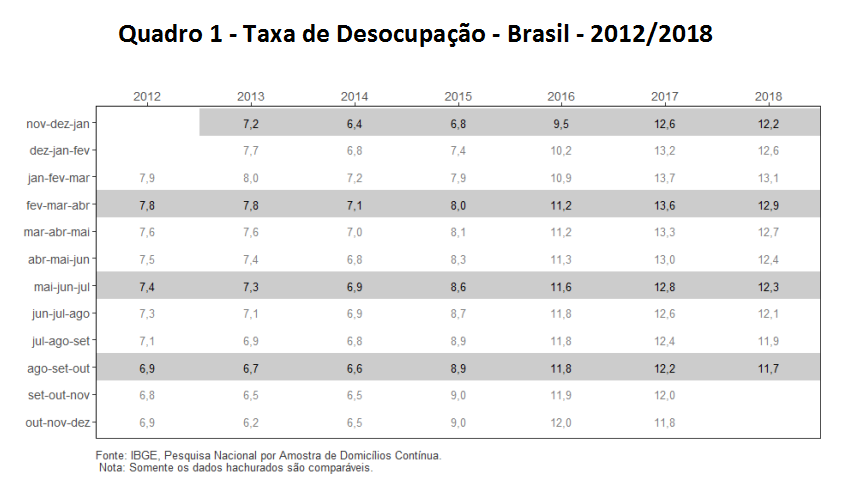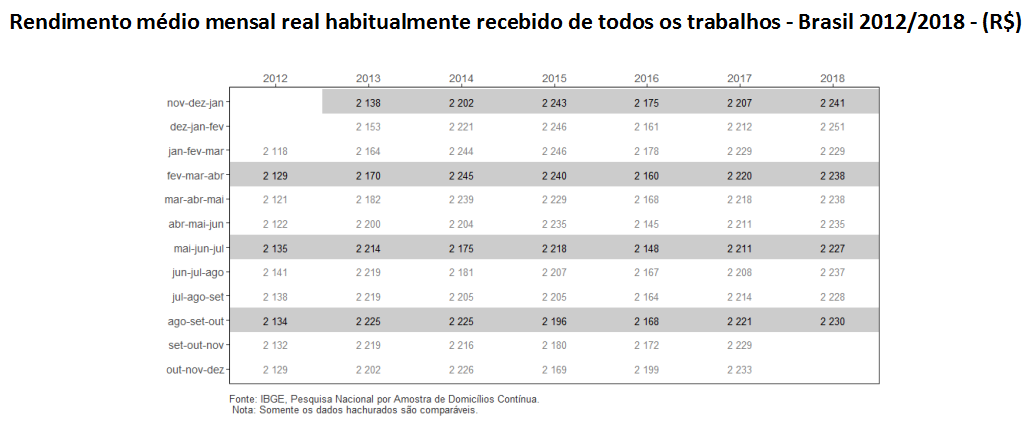Continuous PNAD: unemployment rate is 11.7% and underutilization rate is 24.1% in quarter ended in October 2018
November 29, 2018 09h00 AM | Last Updated: November 30, 2018 09h33 AM
The unemployment rate (11.7%) declined 0.6 percentage points in the moving quarter ended in October 2018 in relation to the May-July quarter of 2018 (12.3%).
Compared to the same moving quarter of 2017 (12.2%), it dropped (-0.5 percentage points).
| Indicator/Period | Aug-Sep-Oct 2018 | May-Jun-Jul 2018 | Aug-Sep-Oct 2017 |
|---|---|---|---|
| Unemployment rate | 11.7% | 12.3% | 12.2% |
| Underutilization rate | 24.1% | 24.5% | 23.8% |
| Usual real earnings | R$2,230 | R$2,227 | R$2,221 |
| Change of the usual real earnings in relation to: | 0.1% (stability) | 0.4% (stability) | |
The unemployed population (12.4 million) fell 4.0% (517 thousand less persons) in relation to the quarter of May to July 2018. In the comparison with the same quarter of 2017, there was reduction of 3.1%(389 thousand less persons).
The employed population (92.9 million) increased 1.4% (1.2 million more persons) in relation to the quarter of May to July 2018 and%1.5 (1.4 million persons) in the comparison with the quarter from August to October 2017.
The labor underutilization rate (24.1%) in the quarter from August to October 2018 changed -0.4 percentage points in relation to the previous quarter (24.5%). It remained stable when compared with the same quarter in 2017 (23.8%).
The underutilized population (27.2 million) was stable over the quarter from May to July 2018 (27.6 million). In relation to the same quarter of 2017 (26.6 million), it grew 2.6% (+696 thousand persons).
The discouraged population (4.7 million) was stable over the quarter from May to July 2018 and increased 10.6% in relation to the same quarter of 2017 (4.3 million).
The percentage of discouraged persons (4.3%) was stable in relation to the previous quarter and increased 0.4 percentage points in the comparison with the same quarter of 2017 (3.9%).
The contingent of persons employed in the private sector with a formal contract (excluding domestic workers) was 32.9 million persons, staying stable both comparisons. Conversely, the number of employed persons without a formal contract (11.6 million persons) grew 4.8% in relation to the previous quarter (534 thousand more persons). It rose 5.9% (649 thousand more persons) in relation to the same quarter in 2017. The number of self-employed workers (23.6 million persons) rose 2.2% compared with the previous quarter (497 thousand more persons) and 2.9% in relation to the same quarter of 2017 (655 thousand more persons).
The usual real average earnings (R$2,230) stayed stable in both comparisons, just as the usual real wage bill (R$202 billion).
The complete publication, the presentation and summary tables of the Continuous PNAD are in this page.
The unemployment rate (11.7%) declined 0.6 percentage points in the moving quarter between ended in October 2018 in relation to the May-July quarter of 2018 (12.3%). It dropped (-0.5 percentage points) in relation to the same moving quarter in 2017, when the rate was estimated at 12.2%.
In the August-October quarter of 2018, 12.4 million persons were unemployed in Brazil. In the comparison with the quarter of May to July of 2018, there was a drop of 4.0% (-517 thousand persons). Compared with the same quarter of 2017, this estimate changed -3.1%, representing a reduction of 389 thousand unemployed persons in the workforce.
The compound rate of labor underutilization (percentage of unemployment, time-related underemployment and the potential workforce) was estimated at 24.1% in the quarter from August to October 2018, recording a change of -0.4 percentage points in relation to the previous quarter (24.5%) and stability in relation to the same quarter of 2017 (23.8%).
In the quarter from August to October 2018, there was nearly 27.2 million of persons in the labor underutilization contingent in Brazil. Such figure presented stability, i.e., had no significant change in relation to the quarter from march to May 2018, when the underutilization was estimated at 27.6 million persons. Compared with the same quarter last year, when there were 26.6 million underutilized persons, this estimate changed 2.6%, representing an amount of 696 thousand more underutilized persons.
The contingent of time-related underemployed persons (7.0 million) increased 6.4% in relation to the previous quarter, 418 thousand more persons. This indicator also posted a positive change (10.5%) in relation to the same quarter last year, when there were 6.3 million underemployed persons in Brazil
The number of persons out of the workforce (65.1 million) had a reduction of -383 thousand (-0.6%) when compared to the quarter of May to July 2018. Over the same quarter a year ago, there was expansion of 0.9% (an increase of 611 thousand persons).
The number of discouraged persons (4.7 million) was stable in relation to the previous quarter and increased 10.6% in relation to the same quarter of 2017.
The percentage of discouraged workers in relation to the workforce or discouraged population(4.3%) stood stable over the previous quarter (4.4%) and rose 0.4 percentage points, in relation to the previous moving quarter (3.9%).
The contingent in the workforce – employed and unemployed persons – was estimated at 105.3 million persons in the quarter between August to October 2018. IN comparison with the previous quarter, there was an increase of 724 thousand persons (0.7%). Over the same quarter a year ago, there was expansion of 0.9% (an increase of 967 thousand persons).
The employed population (92.9 million) increased 1.4% over the previous quarter (more 1.2 million persons). It increased 1.5% (1.4 million more persons) over the same quarter in 2017.
The employment-population ratio – percentage of employed persons at working age – was estimated at 54.5% in the August-October quarter of 2018, a rise of 0.6 percentage points over the previous quarter (53.9%). In relation to the same quarter of 2017, there was stability.
The contingent of persons employed in the private sector with a formal contract (excluding domestic workers) was 32.9 million persons, staying stable both against the previous quarter and the same quarter of 2017.
The number of persons employed in the private sector without a formal contract (11.6 million persons) increased in relation to the previous quarter (4.8%), representing 534 thousand more persons. It rose 5.9% (649 thousand more persons) in relation to the same quarter in 2017.
The number of self-employed workers (23.6 million persons) rose 2.2% compared with the previous quarter (497 thousand more persons) and 2.9% in relation to the same quarter of 2017 (655 thousand more persons).
The category of employers (4.5 million persons) remained stable in relation to the previous quarter. It rose (4.8%) in relation to the same quarter a year ago, representing an increase estimated at 205 thousand more persons.
The category of domestic workers (6.3 million persons) remained stable when compared with the previous quarter and also compared to the same quarter of 2017.
Estimated at 11.7 million persons, the group of persons employed in the public sector (including statutory servants and military) was stable against the previous quarter and the same quarter of 2017.
The average usual real earnings from all jobs of employed persons (R$2,230) stood steady in both comparisons.




